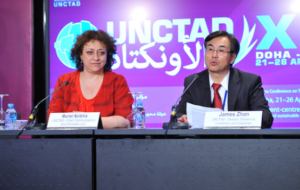Sleeping Giants: Sovereign Wealth Funds and Diversification
Sovereign wealth funds (SFWs) function essentially as a way of categorizing assets held by governments in different currencies. When any particular government has a current account surplus, it often will reinvest its excess money in the form of a state-owned investment fund or a sovereign wealth fund. The world’s first modern SFW, the Kuwait Investment Authority, has seen the exponential growth of these state-run funds. Today, with the world’s largest funds coming directly out of states dependent on oil revenue, such as Saudi Arabia, the United Arab Emirates (UAE), Kuwait, Qatar, and Norway. These states manage much of the estimated 7.3 trillion dollars in global sovereign wealth funds. As many of these economies push themselves ever harder to diversify, their SFWs will catalyze change. SFWs are most notable for their sheer size: JPMorgan & Chase, the largest bank in the United States, has a market cap of almost $297 billion, while Bridgewater Associates, the largest hedge fund, has about $150 billion dollars under management. By comparison, Norway’s SFW, the Pension Fund Global, is worth $885 billion dollars as of January 2017, followed by the Abu Dhabi Investment Authority at $792 billion dollars. At first glance, these numbers seem hard to fathom, but only become more incredible when considering that at least 40 new SFWs have been created since 2005. Since 2008, these assets have grown by nearly 60 percent. Norway’s SFW alone controls more than 1 percent of all listed shares in the world, with assets held in more than 9,000 firms across 78 countries. While the media concentrates on Wall Street banks and Silicon Valley start-ups, SFWs represent the sleeping giants of the global economy.
SFWs primarily go unnoticed because they are generally rather boring. When handling the sovereign wealth of an entire country, bankers need to refrain from doing anything that might risk burning up significant amounts of foreign currency needed to balance the budget. Keeping with the Norwegian example, a rare democracy with its own SFW, economists argue that the fund could be $150 billion dollars richer should it take riskier, often illegal investments. For commodity-dependent states, when oil prices start to plunge, it proves increasingly difficult for countries to balance their budgets on commodities revenue. In response, they have used SFWs as a creative tool for economic diversification.
Of the SFWs that could radically reshape their host economies, the favorite is undoubtedly Saudi Arabia’s. The country recently published its Vision 2030, an 84-page report detailing the Saudi intention to restructure and diversify its economy. The country hopes “to increase the Public Investment Fund’s (PIF) assets, from SAR 600 billion (US $159 billion) to over SAR 7 trillion (US $1.87 trillion).” The report outlines various possible methods of raising such capital, but most notably includes floating shares of the state owned oil giant, Saudi-Aramco, and using the liquidated shares to directly fund the PIF. Exactly how much of the company will sell at what price and when remains ambiguous; however, according to Prince Muhammad bin Salman, it could start as soon as this year.

Should the revitalization of the Saudi PIF transpire as Prince Salman wishes, it would create the largest SFW in the world and play a heavy hand in diversifying the country’s government revenue. However, with a nearly $2 trillion slush fund, the Saudis would cast a shadow beyond its borders. According to the Salman, the PIF “will be the main engine for the whole world and not only the region… there will be no investment, movement or development in any region of the world without the vote of the Saudi sovereign fund.” With neighboring Gulf economies and other petro states feeling the same burden of low oil prices, it seems likely that they will follow in the Saudi’s stead. The sleeping giants may just be waking up.

Chad is an undergraduate in the School of Foreign Service majoring in International Politics with a concentration in Security. Outside of academics Chad is an avid photographer and traveller.
